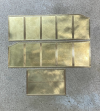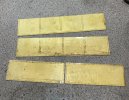Jon Nazareth
Western Thunderer
I have some spare tender etches from the Jennifer Who project so, I decided to make them up into a wagon. It’s going to be very loosely based on the early curved end LNWR wagon designed by Henry H Henson. It would have been nice to have had the curved ends but that seemed like a bridge too far for my limited skills.
The tender sides are 57mm high but I’ve reduced this for the wagon to 29mm. The photos show the before and after with the etches and, if I get time, I’ll start drilling out for the rivets, I’ve ordered more, this afternoon. I’m thinking of using angle sections in the corners and to make any sense of them, I’m going to have to have rivets or the appearance of rivets showing on the inside. I have a few ideas, not sure if they’ll work, but I’m hoping that more will come in time . I used soldered angle in the corners of the tender but they are tucked away inside the tank and can’t be seen. Very early days with this build.
Jon

This is the Henson wagon that I’m basing my effort on.

Full height tender sides.

Sides cut down to 29mm.
The tender sides are 57mm high but I’ve reduced this for the wagon to 29mm. The photos show the before and after with the etches and, if I get time, I’ll start drilling out for the rivets, I’ve ordered more, this afternoon. I’m thinking of using angle sections in the corners and to make any sense of them, I’m going to have to have rivets or the appearance of rivets showing on the inside. I have a few ideas, not sure if they’ll work, but I’m hoping that more will come in time . I used soldered angle in the corners of the tender but they are tucked away inside the tank and can’t be seen. Very early days with this build.
Jon

This is the Henson wagon that I’m basing my effort on.

Full height tender sides.

Sides cut down to 29mm.
Last edited:











